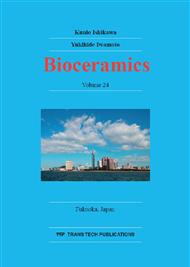[1]
G. Macauro, C. Pioni, W. Burger, L. Pilloni, E. De Santis, F. Muratori, Fracture of a Y-TZP ceramic femoral head. Analysis of a fault. J. Bone Joint Surg. Br (2004) 86, 1192-6.
DOI: 10.1302/0301-620x.86b8.15012
Google Scholar
[2]
J. Chevalier, What future for zirconia as a biomaterial? Biomaterials (2006) 27, 535-43.
Google Scholar
[3]
D. Casellas, M.M. Nagl, L. Llanes, M. Anglada, Fracture toughness of alumina and ZTA ceramics: microstructural coarsening effects, J. Mater. Process. Technol. 143-144 (2003) 148-152.
DOI: 10.1016/s0924-0136(03)00396-0
Google Scholar
[4]
F. Meng, C. Liu, F. Zhang, Z. Tian, W. Huang, Densification and mechanical properties of fine-grained Al2O3–ZrO2 composites consolidated by spark plasma sintering, J. Alloys Compd. 512 (2012) 63-67.
DOI: 10.1016/j.jallcom.2011.09.015
Google Scholar
[5]
J. Chevalier, B. Cales, J. M. Drouin, Low temperature aging of Y–TZP ceramics, J. Am. Ceram. Soc. 82 (1999) 2150–2154.
DOI: 10.1111/j.1151-2916.1999.tb02055.x
Google Scholar
[6]
A.H. De Aza, J. Chevalier, G. Fantozzi, M. Schehl, R. Torrecillas, Crack growth resistance of alumina, zirconia and zirconia toughened alumina ceramics for joint prostheses, Biomaterials 23 (2002) 937–945.
DOI: 10.1016/s0142-9612(01)00206-x
Google Scholar
[7]
I. Akin, E. Yilmaz, F. Sahin, O. Yucel, G. Goller, Effect of CeO2 addition on densification and microstructure of Al2O3–YSZ composites, Ceram. Int. 37 (2011) 3273–3280.
DOI: 10.1016/j.ceramint.2011.05.123
Google Scholar
[8]
K. Tsukama, Conversion from β-Ce2O3. 11Al2O3 to α-Al2O3 in tetragonal ZrO2 matrix, J. Am. Ceram. Soc. 83 (2000) 3219–3221.
Google Scholar
[9]
K. Duan, R. Wang, Surface modifications of bone implants through wet chemistry, J. Mater. Chem. 16( 2006) 2309-232.
DOI: 10.1039/b517634d
Google Scholar
[10]
N.R.F. A. Silva, I. Sailer, Y. Zhang, P. G. Coelho, P. C. Guess, A. Zembic, R. J. Kohal, Performance of zirconia for dental healthcare, Materials 3 (2010) 863-896.
DOI: 10.3390/ma3020863
Google Scholar
[11]
F. Hattab, The state of fluorides in toothpastes, J. Dent. 17 (1989) 47-54.
Google Scholar
[12]
A. Pearce, R. G. Richards, S. Milz, E. Schneider, S. G. Pierce, Animal models for implant biomaterial research in bone: a review, European Cells and Materials13 (2007) 1-10.
DOI: 10.22203/ecm.v013a01
Google Scholar
[13]
V. Simon, D. Eniu, A. Gritco, S. Simon, Thermal and spectroscopic investigation of sol-gel derived aluminosilicate bioglass matrices, JOAM 9, 11 (2007)3368-3371.
Google Scholar
[14]
V. Simon, S. Cavalu, I. Akin, O. Yucel, G. Goller, XRD and FTIR investigation of zirconia- toughened alumina composites, Studia UBB Physica, LVI, 1 (2011) 67-71.
Google Scholar
[15]
C. Piconi, G. Maccauro, F. Muratori, E. Brach del Prever, Alumina and Zirconia ceramics in joint replacements, J. Applied Biomaterials&Biomechanics 1 (2003) 19-32.
DOI: 10.1007/978-1-84882-664-9_5
Google Scholar
[16]
K. Mustafa, A. Wennerberg, K. Arvidson, E. B. Messelt, P. Haag, S. Karlsson, Influence of modifying and veneering the surface of ceramic abutments on cellular attachment and proliferation, Clin. Oral Impl. Res. 19 (2008) 1178-1187.
DOI: 10.1111/j.1600-0501.2008.01560.x
Google Scholar


